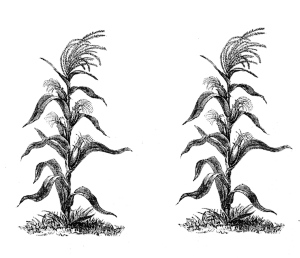Bill Neal’s liver & cornmeal pudding
The cornmeal of course is the southern component; you could further Anglicize this pudding by substituting breadcrumbs, but we never do so. We do, however, substitute cayenne for Neal’s red pepper flakes (as usual) and mace for his nutmeg.
 -about 1 ¾ lb pork or calf’s liver cut into half inch chunks
-about 1 ¾ lb pork or calf’s liver cut into half inch chunks-2 Tablespoons lard (preferred) or unsalted butter
-6 whole allspice
-¼ teaspoon ground bay or a bay leaf (but see ‘further notes’)
-¾ teaspoon whole peppercorns
-¾ teaspoon rubbed sage
-¾ teaspoon dried thyme
-4 oz pork fat, chopped fine
-2 cups chopped onion
-2 beaten eggs
-½ cup cornmeal
-1 teaspoon coarsely cracked black pepper
-½ teaspoon cayenne
-½ teaspoon mace
-another teaspoon rubbed sage
-another teaspoon dried thyme
-1 ½ teaspoons salt
1. Bring the liver to a boil in enough water to cover and keep ½ cup of the cooking liquid.
2. Crack the allspice, bay, whole peppercorns and first tranches of sage and thyme together, either with a mortar and pestle or in a spice grinder.
3. Grease the loaf pan with the lard or butter and coat the pan evenly with the cracked seasonings from Step 2.
Preheat the oven to 375°
5. Mix together the pork fat, onion and eggs, then fold in the liver.
6. Heat the reserved cooking liquid and stir it into the cornmeal, let it cool and then combine it with the liver mixture.
7. Mix all the seasonings into the pudding batter and destroy it in a food processor if you have one; do not worry if you do not, the texture will be coarser and different, no worse.
8. Carefully spoon the batter into the pan without knocking the cracked seasonings off of its sides and cover it tightly with foil.
9. Put the loaf pan in the bigger pan and pour boiling water to a depth of about an inch around the loaf pan.
10. Bake the pudding until it pulls away from the sides of the loaf pan and its internal temperature reaches 165°, usually about an hour.
11. Let the pudding cool, turn it out of the loaf pan and refrigerate it wrapped snugly in plastic.
12. To serve the pudding, cut it into ½ inch thick slices, dust it with seasoned flour and fry until crisp.
Further notes:
- It is more than passing difficult to pulverize bay, and since nobody wants knifelike shards of bay in his or her system, the bay needs to be finely powdered. That presents a problem, because the other seasonings for the outside of the pudding ought to be coarse, so we recommend powdered bay, especially if you do not have a spice mill. If you do have one, be careful not to overprocess the spice and herbs.
- Neal cuts his liver into bigger, one inch chunks, which is fine unless you do not have a food processor (see Step 7).
- Raw liver is elastic and therefore can be awkward to cut. If you put the liver in the freezer for 10-15 minutes, however, it will be a little easier to handle. In general, liver freezes pretty well for storage too. This pudding is a particularly appropriate use of liver that has been frozen because texture is not an issue.
- Instead of parboiling the liver, you can grind it raw, but then you will need to cook the pudding longer, for almost two hours, and will not have any livery liquid; then you would need to substitute pork, beef or chicken stock at Step 6. That might make the pudding more palatable to people wary of liver, but it misses the point of the preparation and you are not likely to get those people to try it anyway.
- Pork liver is widely available all over Britain but is extremely hard to find in the United States. The Editor has bought fresh pork liver in Boston’s Chinatown and has found it frozen in Chinese groceries, both in Rhode Island and New York. Sometimes big supermarkets in neighborhoods with a Hispanic or Portuguese population, like Seabra’s in the Newark Ironbound, stock it too.
- Neal advises his reader to fry the liver in any fat of preference: “bacon, butter, lard or vegetable oil.” (Southern Cooking 98) We like bacon fat best.

